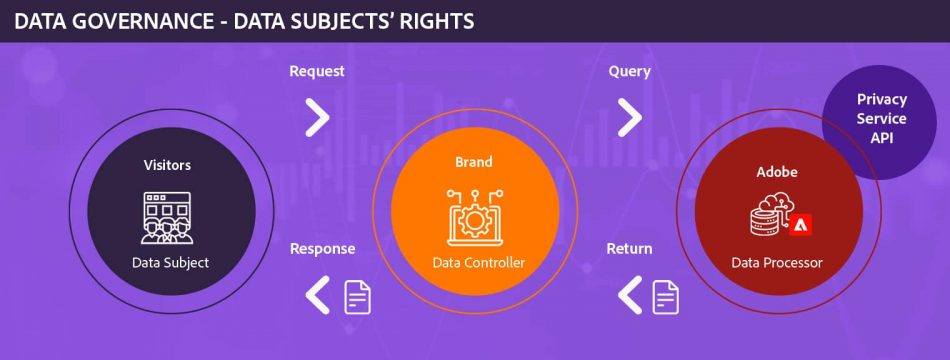
Data is an important asset for any business. Businesses deal with a large volume and variety of data to make well-informed decisions. They always look for “how to add more value and bring meaning to data”. To understand data assets, how to access them, and how to use that data most effectively; Data governance helps to maximize the value of data while maintaining its consistency across the organizations.
Data governance makes sure that data is governed properly, protected, secured, and is in compliance. This is crucial for every business, as they are collecting data from various sources. In this blog, we will walk you through how Adobe Analytics can help you govern or protect data while taking care of customers’ rights as well.

Adobe Analytics GDPR and CCPA
Data governance is not a new concept in Adobe Analytics. However, Adobe is always looking to incorporate additional capabilities and enhance the functionality to help brands manage GDPR and CCPA. When you use Adobe Analytics, it works as a data processor as well. It receives, stores, and processes data according to your company’s permission and instructions. As a data controller, you will determine the personal data that should be processed and stored by Adobe on your behalf.
Data governance features in Adobe Analytics enable data governance policy to use data. Let’s see how it supports GDPR and CCPA and how you can you manage your data more efficiently.
There are three important parts of Data governance in Adobe Analytics
- Consent Management
- Data Governance
- Data Subject’s Right
Consent Management?
First, brands need to understand what data needs to be collected, how to collect, and what consent they need to get from the customers. They also need to determine what data is collected now and in the future.
Moreover, it is the customers’ right to know or understand what data is collected and the brand’s right to understand its digital performance as well. Data governance makes all these possible. This is why building a proper due diligence on data collection is not important but it becomes mandatory to keep transparency and integrity. You should determine how the data will be used and processed.
For efficient data management, you need to check how to get consent from the customers and whether the present consent is sufficient or not. It can be done internally or you can get help from a third party. It is important to make sure that you have the right approach that aligns with your brand. You must ensure that you adopt a proper approach for honoring consumers opt-outs or withdrawal of consent whenever they want.
What Are the Steps You Need to Take for Consent Management?
After implementing Adobe Analytics, you send a beacon. Now, it is your responsibility to initiate the beacon and you should avoid the default setting when you configure the Adobe Analytics extensions otherwise everything would be tracked without consent. Make sure, you are not sending any beacons with default settings and you do not enable auto data collection. When consent is in place, everything cannot be enabled as it is not compliant with consent management and policy.
A simple way to manage consent is to use “Opt in” services in AEP instead of a third-party extension for consent. This will help you to get consent and then you can trigger beacon.
Data Retention and Governance
After collecting data, data governance is important to make sure that the data is properly labelled and governed. Ensure that collected data has proper retention and governance policy and you have reviewed the current tags and cookies to align it with your use cases. Follow these three steps:
IDENTITY RESOLUTION AND STRATEGY
Collecting PAA in Adobe Analytics is not recommended. You should have an identity strategy to identify customers, such as loyalty ID, one-on-one mapping ID, etc. Knowing the customer helps improve the personalization strategy across various devices and platforms.
DATA RETENTION
Once the data is collected, you need to set an appropriate data retention period. In Adobe Analytics, by default the data retention time period is 25 months, you can extend this time period by up to 10 years by contacting a support representative.
DATA LABELING
Labeling all the variables captured to operationalize the governance practice and policies is important too. Why it is important?, because it helps-
- to identify the data subject,
- to determine which data should be returned to the customers
- determine which data should be deleted
Point to remember: You cannot bypass the data retention process and directly go to data labeling.

Data Subject’s Right
Once the data is collected, you should take care about customer’s right for the data. What if customers want to opt out, want to understand what data is being collected, and want to delete those data in future. GDPR and CCPA in Adobe Analytics will help you manage the right to access and right to delete.
You must take care of these three points:
- You need to understand how you will receive and respond to the data subject requests. you require a system or automated system to manage these requests.
- You should have identifiers to authenticate the user ID from identifiable data. You require a strategy to determine how ID will be identified. In Adobe Analytics, ECA (Experience cloud applications) service which is a cookie id or device id service will help you.
- After receiving the request, you have to review the data to determine what data has to be presented to the customers. As, the collected data also includes information that may not be useful for the customers such as the browser’s name, browser’s versions, java versions, etc. So, you need to clean the data and review it before presenting it to the customers.
Keeping Pace With the Evolution of Data Governance
No one can deny the fact that data governance is here to stay because brands will keep using the data to improve their business decisions, performance, and business results. They require clean and optimized data on which everyone can rely. All in all, the importance of data governance will keep increasing with time as more data will be created, new technologies will be introduced, and more regulations will be coming.
If you need help with data governance in Adobe Analytics or any other Adobe Technologies, do let us know at sales@nextrow.com.
For more information about Data governance in Adobe Analytics, watch this on-demand webinar video here.
Get In Touch
Driving business growth by transforming challenges into opportunities with innovative, tailored solutions that deliver measurable results.

